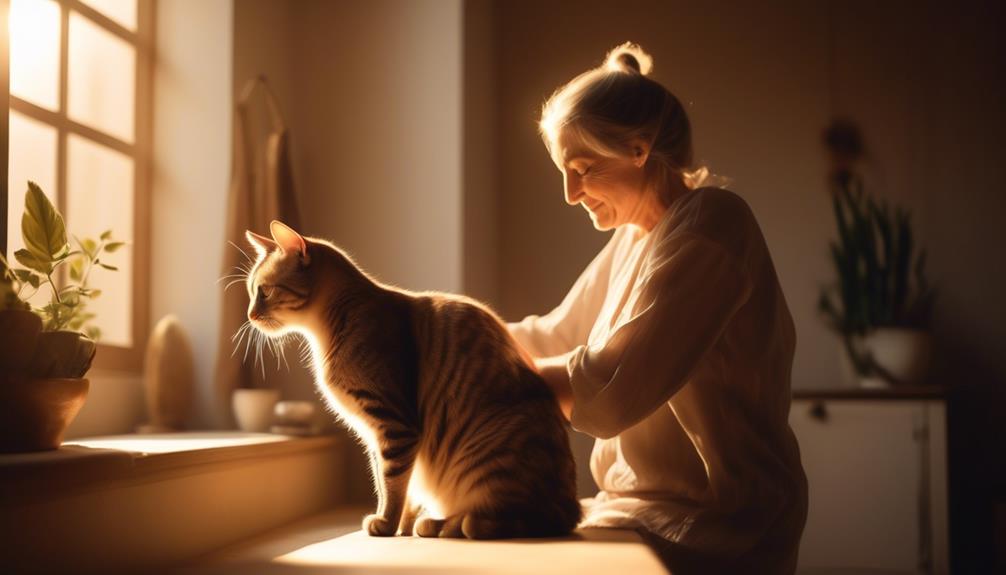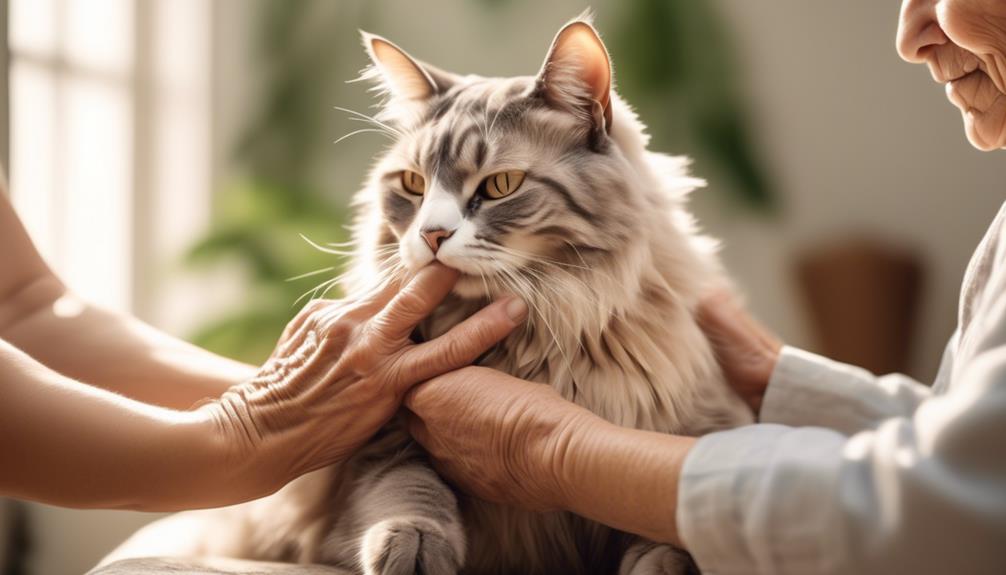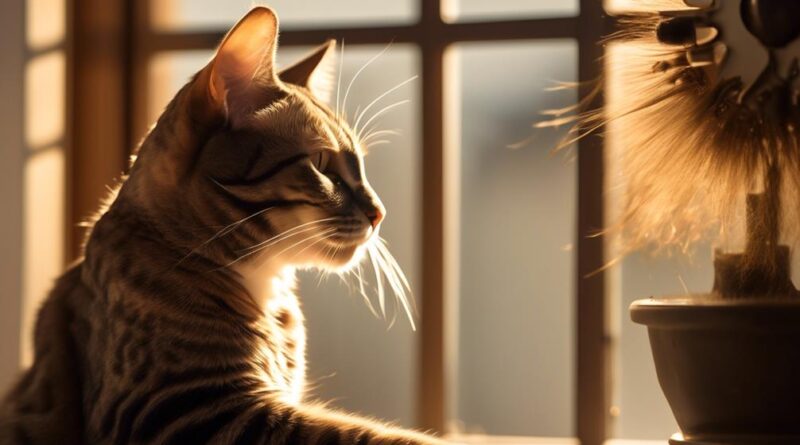What Is the Optimal Time for Cat Grooming?
So, you've decided to tackle the age-old question of when to groom your feline friend. It's a topic that has sparked many debates among cat owners, each claiming to have the ultimate answer. But fear not, for in this discussion, we'll explore the various factors that come into play when determining the optimal time for cat grooming.
From considering your cat's daily routine to the different grooming needs of kittens and senior cats, there's a lot to cover. So, let's unravel the mystery together and uncover the best approach for your purrfect companion.
Morning Grooming

Start your day off right by giving your cat a gentle morning grooming session to keep their coat healthy and their bond with you strong. Brushing your cat in the morning not only helps in maintaining their coat but also sets a positive tone for the day.
When using brushing techniques, it's important to start with a soft-bristled brush and gently stroke in the direction of their fur growth. This not only removes loose hair and prevents matting but also stimulates natural oil production, keeping their coat glossy and skin healthy.
Incorporating morning grooming into your routine also provides an opportunity for bonding with your feline friend. It's a peaceful time when your cat is generally more relaxed, making it a perfect occasion for gentle grooming. This strengthens your bond as it fosters trust and comfort between you and your pet.
Moreover, morning grooming helps in coat maintenance by preventing hairballs. Cats groom themselves by licking, which leads to the ingestion of loose hair. Regular brushing reduces the amount of loose hair your cat ingests, thus decreasing the likelihood of hairballs. This is especially crucial for long-haired breeds.
Afternoon Grooming
Consider giving your cat a brief afternoon grooming session to help maintain their coat and promote relaxation. Afternoon grooming can be a calming activity for both you and your feline friend. When it comes to brushing technique, opt for a soft-bristled brush to gently remove any tangles or mats. Start by brushing in the direction of your cat's fur growth to prevent discomfort. This technique not only helps to keep your cat's coat looking its best but also provides a soothing bonding experience.
Furthermore, afternoon grooming plays a significant role in shedding prevention. Regularly brushing your cat in the afternoon can help reduce the amount of loose fur they swallow while grooming themselves, which in turn can lower the occurrence of hairballs. By establishing a consistent grooming routine, you can effectively manage your cat's shedding and minimize the amount of loose fur around your home.
During the afternoon grooming session, take the opportunity to check for any skin issues, lumps, or bumps. This hands-on approach allows you to monitor your cat's overall health while engaging in a beneficial grooming routine. Remember to keep the grooming sessions short and positive, ensuring that your cat associates grooming with comfort and care.
Evening Grooming
You can enhance your cat's grooming routine by incorporating evening grooming into your daily schedule. Evening grooming can be a relaxing routine for both you and your cat. After a long day, grooming your cat in the evening can provide a calming and soothing experience for your feline friend. This is also an excellent opportunity for bonding time, as your cat will likely be more relaxed and receptive to your attention in the evening.
Grooming your cat in the evening can help them unwind and destress from the day's activities. Cats are often more active during the day, so an evening grooming session provides a chance for them to settle down and enjoy the attention and care you provide. This can help create a positive association with grooming and strengthen the bond between you and your cat.
Furthermore, evening grooming can fit seamlessly into your daily routine. It can serve as a way for you to wind down as well, as you spend quality time with your cat. By incorporating evening grooming into your schedule, you can ensure that your cat receives the necessary care and attention while also creating a peaceful and enjoyable experience for both you and your feline companion.
Pre-Feeding Grooming
Enhancing your cat's grooming routine can be achieved by incorporating pre-feeding grooming into your daily schedule. This practice not only helps in maintaining your cat's coat but also provides a bonding opportunity. Here are the benefits of pre-feeding grooming and some techniques to make the most of this time with your feline friend:
- Benefits of Pre-Feeding Grooming
- *Stress Reduction*: Grooming your cat before feeding can help reduce any stress or anxiety they may have, creating a more relaxed environment during mealtime.
- *Improved Coat Health*: By grooming your cat before they eat, you can remove any loose fur, dirt, or tangles, preventing them from ingesting it during their meal.
- *Bonding Time*: Grooming your cat before feeding can be a calming and bonding experience for both you and your pet, strengthening your relationship.
- Techniques for Pre-Feeding Grooming
- *Brushing*: Use a soft-bristled brush to gently remove loose fur and distribute natural oils throughout your cat's coat. This can help prevent matting and reduce shedding.
- *Eye and Ear Cleaning*: Check and clean your cat's eyes and ears before mealtime using a damp cloth or cotton ball. Be gentle and cautious to avoid any discomfort.
- *Paw Inspection*: Take a moment to inspect your cat's paws for any debris or overgrown nails. This is also a good time to trim their nails if needed, but do so carefully to avoid causing any pain.
Incorporating pre-feeding grooming into your cat's daily routine can contribute to their overall well-being and strengthen the bond between you and your furry companion.
Post-Playtime Grooming
After playtime, give your cat a gentle brush to remove any loose fur and debris, helping to maintain their coat and prevent matting. When your feline friend has finished their play session, it's the ideal time to attend to their grooming needs. Grooming techniques post-playtime are crucial to keeping your cat's coat healthy and shiny.
Use a soft-bristled brush to carefully groom your cat, focusing on removing any tangles or mats that may have formed during their active play. This not only keeps your cat looking their best but also contributes to their overall well-being.
In addition to brushing, consider using grooming products specifically designed for cats. Look for products such as grooming wipes that are gentle on your cat's skin and help remove any dirt or odor accumulated during play. These wipes are an efficient way to freshen up your cat after playtime without the need for a full bath.
Furthermore, using a cat-specific de-shedding tool can help manage your cat's shedding, especially after an energetic play session. These tools are designed to remove loose fur efficiently without causing any discomfort to your pet.
After playtime, grooming your cat not only helps maintain their appearance but also fosters a strong bond between you and your pet. By incorporating these grooming techniques and products into your post-playtime routine, you can ensure that your cat's coat remains healthy and their grooming needs are met.
Seasonal Grooming Considerations
Considering the changing seasons, it's important to adjust your cat's grooming routine to address specific seasonal needs. Cats experience variations in shedding patterns and temperature sensitivity, making seasonal grooming considerations crucial. Here are a few key points to keep in mind:
- Shedding Patterns: Cats tend to shed more during seasonal changes, especially in the spring and fall. As the weather warms up, cats shed their thick winter coats, and as it cools down, they grow in a new one. Regular brushing during these times can help minimize shedding around your home and prevent matting.
- Temperature: During hotter months, cats may benefit from a light trim to help them stay cool. However, in colder months, it's important to let their fur grow out to provide insulation. Be mindful of your cat's comfort and adjust grooming practices accordingly.
- Coat Maintenance: Humidity levels can impact your cat's coat. In drier climates, using a moisturizing shampoo and conditioner can help prevent dry, flaky skin. Conversely, in more humid environments, cats may be more prone to matting, so regular brushing is essential.
Grooming for Senior Cats

As your cat ages, adapting their grooming routine becomes increasingly important to maintain their comfort and well-being. Senior cats often need special attention when it comes to grooming. They may not be as flexible or agile as they once were, and their coats may require extra care.
When grooming senior cats, it's crucial to use gentle grooming techniques to ensure their comfort and minimize any potential discomfort.
Senior cat coat care is a vital aspect of grooming for older felines. As cats age, their skin becomes more delicate, and their coats may become prone to tangles and matting. Regular brushing using soft, gentle brushes can help prevent mats and distribute natural oils, keeping their coat healthy and shiny. Additionally, a senior cat's grooming needs may change due to conditions like arthritis or other age-related ailments. It's essential to be mindful of any sensitivities or discomfort they may experience during grooming.
When grooming your senior cat, it's important to create a calm and relaxing environment. Choose a quiet and peaceful space for grooming sessions, and provide plenty of support and stability for your cat, especially if they have mobility issues. Be patient and allow them to take breaks if needed during the grooming process.
Grooming for Kittens
Grooming kittens requires gentle handling and regular maintenance to acclimate them to the process and keep their fur healthy. When grooming kittens, it's important to use gentle techniques and to make the experience as positive as possible to ensure they grow up to be comfortable with grooming activities. Here's a guide to grooming kittens:
- Kitten Socialization and Trust Building
- Spend time handling your kitten gently and positively to build trust and get them used to being touched and handled. This can be through petting, playing, and offering treats to create positive associations with human touch.
- Introduce grooming tools gradually and allow the kitten to investigate them at their own pace. Use treats and praise to associate the tools with positive experiences.
- Kitten Coat Care and Grooming Techniques
- Use a soft brush designed for kittens to gently groom their fur. Start with short sessions to get them used to the sensation and gradually increase the duration as they become more comfortable.
- Pay special attention to areas prone to matting, such as behind the ears and under the armpits. Regular grooming helps prevent matting and keeps the kitten's coat in good condition.
- If the kitten gets dirty, use a damp cloth to gently wipe their fur, avoiding the sensitive areas around the face. This helps them get accustomed to being cleaned and prevents them from ingesting dirt during self-grooming.
Frequently Asked Questions
Can Grooming Help Reduce Shedding in Cats?
Grooming your cat regularly can significantly reduce shedding. By grooming them a few times a week, you can help prevent excessive shedding and matting. Brushing and combing are effective in keeping your cat's coat healthy and minimizing shedding.
What Are the Benefits of Using Specific Grooming Tools for Cats?
When grooming your cat, specific grooming tools can be very effective in controlling shedding. By using the right tools, you can help manage your cat's fur and reduce shedding, keeping your home cleaner.
Are There Any Grooming Techniques That Can Help With Matting and Tangles in Cat Fur?
To prevent shedding and keep your cat's fur tangle-free, use dematting techniques like gentle brushing and combing. Regular grooming can help prevent mats and tangles. Aim for a grooming frequency that suits your cat's coat type.
How Often Should Cats With Long Hair Be Groomed Compared to Cats With Short Hair?
For long-haired cats, grooming frequency varies from short-haired ones. Long-haired cats need more grooming to control shedding. Use specific grooming methods for each breed to prevent matting and tangles. Regular grooming helps maintain healthy fur.
Are There Any Specific Grooming Methods or Products That Can Help With Controlling Cat Dander and Allergies?
You can control allergies and reduce dander by using specific grooming methods and products. Regular grooming, such as brushing and bathing, can help minimize dander. Look for grooming products designed to reduce allergens and dander.
Conclusion
So, when it comes to grooming your cat, there's no one-size-fits-all answer. The optimal time for grooming will depend on your cat's individual preferences and needs.
Pay attention to their behavior and body language to determine the best time for grooming sessions. Whether it's in the morning, afternoon, or evening, make sure to create a comfortable and calming environment for your feline friend.
Happy grooming!
